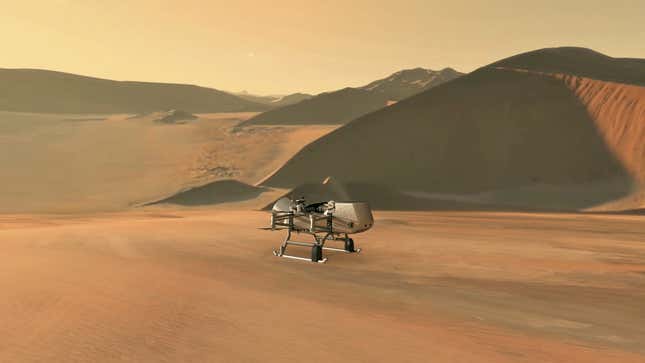
With its oily black seas, hazy golden atmosphere, and electrically charged sand, Saturn’s moon Titan is one of the most intriguing objects in the solar system. Earlier today, NASA approved an exciting new mission that will send a tiny aerial drone to soar above Titan’s alien surface.
Called Dragonfly, the dual-quadrotor drone is the brainchild of the Johns Hopkins Applied Physics Laboratory (APL). The mission, announced by NASA at a press conference today, was chosen over the CAESAR, or Comet Astrobiology Exploration Sample Return, mission, which would’ve sent a spacecraft to retrieve surface samples from comet 67P/Churyumov-Gerasimenko. Both projects fall within NASA’s New Frontiers initiative, in which projects can deployed for $1 billion or less, but at the same time tackle questions with high scientific priority. These two projects were chosen out of an initial field of 12 proposals.

With all due respect to the CAESAR project and its associated Cornell University team, the Dragonfly mission was clearly the better choice. Comet 67P/Churyumov-Gerasimenko was recently visited by the ESA’s Rosetta spacecraft, so it’s still very fresh in our minds. What’s more, the 2006 Stardust mission managed to return comet samples to Earth. CAESAR, with all its charms, has a distinct been-there-done-that quality to it. It’s also doubtful a return mission to the comet would be stir public and scientific attention like a mission to a Saturnian moon.

Indeed, with this mission to Titan we’re in for a real treat. The tiny aerial drone—a dual-quadrotor—will zip from spot to spot, taking measurements and making observations, and all with a bird’s eye view of this incredible world. Flying through the moon’s dense nitrogen-heavy atmosphere, the probe will cover more territory in a few days than a six-wheeled rover could cover in years. Like recreational drones here on Earth, the craft will be able to take off and land vertically.
Titan, which is twice as wide as our Moon, is both very similar to and very unlike Earth. It features a thick atmosphere (it’s actually the only moon in the solar system to have an atmosphere, and it’s thicker than Earth’s), stable liquid at the surface in the form of methane, oceans at a global sea level, lakes and rivers, canyons, and possibly liquid water. Its surface is subject to intense dust storms and rain storms consisting of liquid methane. Among the various goals of the mission, Dragonfly will study whether Titan was once capable of fostering life.

Titan contains thick carbon-rich material that once interacted with liquid water, which may have produced a primordial goop (i.e. prebiotic chemistry) not unlike the one that eventually spawned life on Earth. To that end, Dragonfly will be equipped with a mass spectrometer, gamma ray spectrometer, a camera (capable of both microscopic and panoramic images!), and other instruments.
Mission planners will attempt to land the probe near a group of sand dunes, and have it make a series of hops towards a large crater, explained NASA scientists during today’s press conference, adding that the probe will have to endure temperatures as low as -300 degrees F. Specifically, the probe will explore the Selk impact crater, which may have once held liquid water and complex organics.
Once on Titan, the mission is expected to last for about 2.5 years, during which time the probe will perform around 25 hops and fly a total distance of around 180 kilometers (110 miles), according to NASA.
NASA is expecting to launch the mission by 2026. Sadly, we’ll have to wait until around 2034 for Dragonfly to land on Titan. But it’ll be worth the wait. The images and data this probe will return to Earth will be unlike anything we’ve ever seen before. Yes, ESA’s 2005 Huygens mission to Titan was cool, and it resulted in some cool science and images, but it simply won’t be able to compare with Dragonfly.
Previous missions involved in NASA’s New Frontiers initiative include the New Horizons mission, which visited Pluto and MU69, the ongoing Juno mission around Jupiter, and OSIRIS-REx, which is currently orbiting the asteroid Bennu.